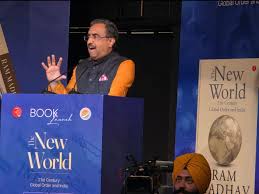Ram Madhav: ‘Even with 8% growth India will reach nowhere… It needs over 10% for 20 years’

In a recent interview with The Indian Express, BJP leader and thinker Ram Madhav shared a bold view on India’s economic future. Despite India’s 8% GDP growth, he said this rate is “nowhere near enough.” According to him, India must grow at over 10% for the next 20 years to truly transform into a global power.
His comments come at a time when India is positioning itself as a major player on the world stage. But Madhav believes ambition alone isn’t enough. The country needs a sustained push—economically, strategically, and culturally.
Why 8% Growth Isn’t Good Enough
Most countries would celebrate an 8% growth rate. For India, Madhav says, that’s not enough. The gap between ambition and reality is wide. India has goals—like becoming a developed country by 2047. To meet them, a higher and consistent growth rate is essential.
Even during its best years, India hasn’t sustained 10% growth. For example, the boom years of the early 2000s saw average growth between 7–9%. But maintaining that for two decades? It’s never happened.
Madhav’s message is clear: India must think beyond short-term success. It needs a long-term economic vision that includes reforms, job creation, and innovation.
Innovation: The Weak Link in India’s Growth
India’s growth is often service-led and technology-backed. However, Madhav points out a major flaw—a lack of original research and innovation. India remains a follower, not a leader, in most areas of technology and science.
The country’s R&D spending is around 0.7% of GDP. That’s far below the U.S. (3.5%) and China (2.4%). Worse, most of this spending is done by government agencies. Private sector participation is minimal.
To catch up, India must change its mindset. It needs to invest in deep-tech, green energy, space, and AI. Schools and universities should foster innovation from a young age. Startups should be encouraged to solve real-world problems—not just mimic Western apps and platforms.
Look East and South, Not Just West
Madhav also touched on India’s foreign policy. Instead of chasing a permanent seat at the UN Security Council, he urges India to focus on building strong ties with its neighbors.
China’s presence in South Asia and the Indian Ocean is growing fast. To counter it, India must build deeper bonds with ASEAN countries, the Indian Ocean Rim, and South Asia. Regional leadership, he argues, will bring faster and more meaningful gains than global status symbols.
India has already started this shift through policies like “Act East” and “Neighbourhood First.” But these strategies need stronger execution. India must lead on trade, security, and connectivity in the region.
Brand Bharat: A Global Identity Beyond the West
Madhav believes India shouldn’t just follow global trends. Instead, it should offer the world a third path—“Brand Bharat.” This brand should focus on democracy, family values, environmental care, and cultural pride.
While Western liberalism and Chinese authoritarianism dominate global systems, India can present an alternative. Its roots in spirituality, non-violence, and coexistence make it unique.
This isn’t just about soft power like yoga or Ayurveda. It’s about building a civilizational identity that balances progress with ethics.
Nationalism, Wokeism, and the Global Shift
Madhav also shared thoughts on global politics. He sees a growing wave of nationalism, especially in the West. Movements like “Make America Great Again” reflect this trend. In response, there’s a rise in “wokeism”—a liberal push to protect progressive values.
This battle between right and left, nationalism and liberalism, is shaping politics across the world. Madhav suggests India should stay focused. It should not get drawn into these ideological wars. Instead, it should create its own balanced, grounded model.
Real Challenges India Must Face
While Madhav’s ideas are bold, India faces real barriers:
- Reforms in land, labor, and the legal system remain incomplete.
- Job creation is not keeping pace with youth entering the workforce.
- Inequality is rising between regions and income groups.
- Education needs a complete overhaul to match future skill needs.
- Environmental sustainability must be central to growth plans.
Moreover, long-term growth must be inclusive and decentralized. Development should reach villages and small towns—not just metro cities.
Is 10% Growth for 20 Years Possible?
Sustained 10% growth is extremely rare. No large economy has done it for two straight decades. But Madhav argues that India can—and must—be the first.
This won’t happen by accident. India will need bold reforms, political stability, better governance, and public-private coordination. A clear national mission is required. Everyone—from entrepreneurs to civil servants—must be aligned with this mission.
The goal is not just higher GDP. It is to lift millions out of poverty, become a global leader in innovation, and offer the world a new model of growth rooted in Indian values.
Final Thoughts: A Vision Worth Chasing
Ram Madhav’s remarks serve as a wake-up call. Settling for 8% growth may offer temporary satisfaction. But it won’t get India to its destiny.
If India rises to the challenge, the rewards will be historic. A richer, stronger, and more confident India can not only transform itself—but also help shape a better world.






